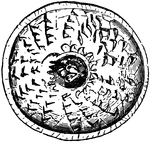Clipart tagged: ‘lamprey’

Lamprey Eel
This lamprey eel has a row of holes on its neck; these are openings that lead to its lungs; there are…

Lamprey Eel
Lampreys are widely distributed. They are found along the Atlantic coast and ascend the rivers. They…
Lamprey
The gills in a lamprey are situated in a number of distinct sacs or pouches which recieve water from…

European lamprey
"The color is yellowish marked with brown. Like the sharks and rays is it without an air bladder; to…

Sea Lamprey
A lamprey is an animal which, though often regarded as a fish, differs from a fish in the absence of…

